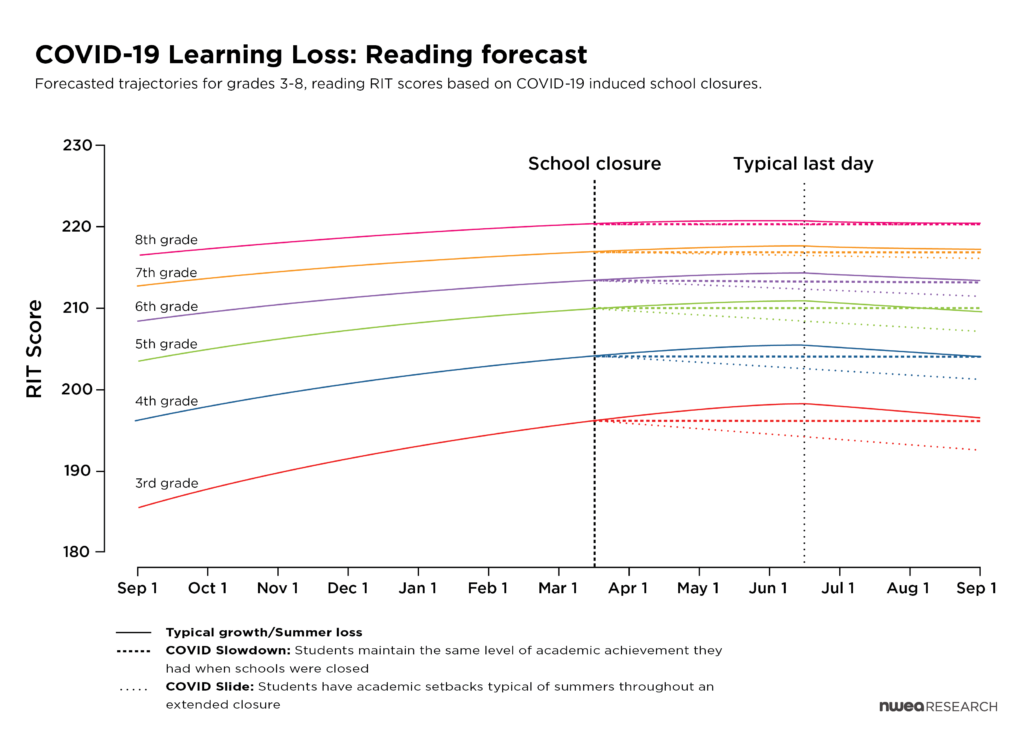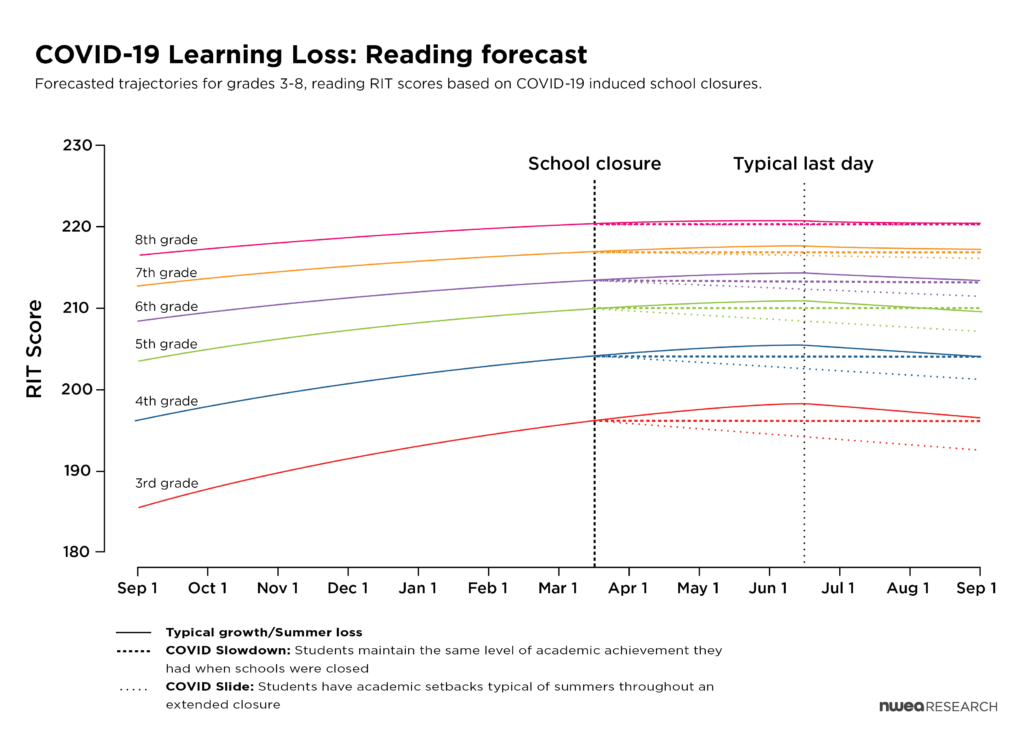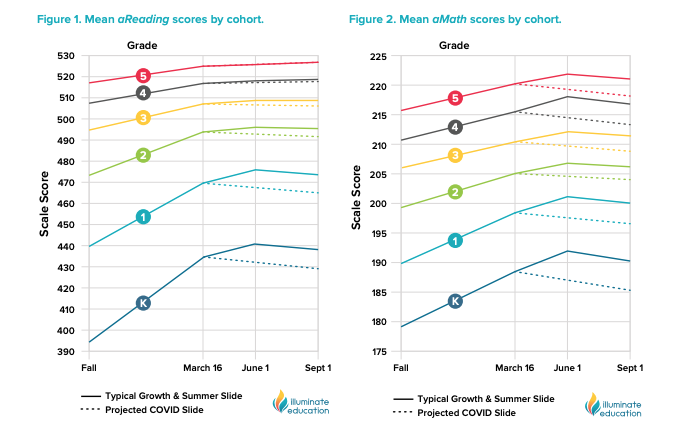It is undeniable that lost instructional time related to the events of 2020 will impact students, the question is – how much? While the research regarding opportunity gaps for students is limited given the lack of available data and disparities in district responses, there is a substantial body of research related to “summer slide” – the inevitable learning loss students experience in the fall following a prolonged period away from direct, in-person instruction.
Based on this research, we know three things:
- Students who experience low socioeconomic opportunities are exposed to summer slide more than their peers.
- Pre-K and elementary school students tend to experience the greatest learning losses, especially when combined with low socioeconomic opportunities.
- Students from historically targeted and oppressed groups experience greater opportunity gaps related to summer slide compared to their peers.
Therefore, we offer the following recommendations:
- Prioritize live, in-person instruction for students in pre-K and elementary school, with a strong focus on addressing the opportunity gaps for historically targeted and oppressed groups, especially students who experience low socioeconomic opportunities.
- Provide short duration, high-intensity tutoring to all students.
- Leverage technology (e.g. texting) to provide consistent contact (at least bi-weekly) to families with a focus on specific research-backed interventions and enrichment activities families can use to help students.
- Mail (or deliver) books to students in their homes.
- Implement at-home interventions that include training for families in conjunction with student instruction.
Introduction
Two months into the 2020-2021 school year, families and educators continue to grapple with the impacts of COVID-19 and issues of racial inequity across the United States. On March 20, 2020, U.S. Secretary of Education Betsy DeVos invited states to apply for a waiver from assessment and accountability requirements pursuant to the Every Student Succeeds Act (ESSA), an invitation Colorado accepted. As a result, predicting learning loss based on the events of 2020 is difficult due to lack of publicly available data. However, researchers have made predictions regarding learning loss based on prior research regarding summer slide.
In April 2020, the Northwest Evaluation Association (NWEA) released a report that followed the trajectory of learning loss by grade from the beginning of pandemic school closures in March based on typical growth/summer loss rates. Based on their modeling, the situation ranges from bleak to dire as it relates to learning loss, with 30-50% predicted learning loss that is larger for earlier grades. Figures 1 and 2 from the NWEA report highlight the serious learning loss expected for students following COVID-19.
Figure 1
Figure 2
Similarly, in an analysis of student cohort data from FastBridge online reading and math assessments, Illuminate Education predicted similar significant learning loss following the pandemic based on typical growth/summer loss. Figure 3 is a visual representation of their findings.
Figure 3
In short, learning loss following COVID-19 is inevitable and it is likely that students from historically targeted and oppressed groups and elementary school students will face the most significant lost learning opportunities.
While the summative effects of the events of 2020 will remain unclear for years, understanding previous research regarding the summer slide can help schools, districts, and families make informed, immediate decisions to mitigate opportunity gaps. To make a well-articulated and informed decision, decision makers must understand which student populations benefit from in-person instruction, which students are likely to experience the greatest opportunity gaps if they do not receive adequate instruction, and what research-backed practices will address the growing opportunity gaps related to the events of 2020.
To that end, this memo answers the following questions:
- Based on what we know regarding learning loss related to the summer slide, which student populations are likely to experience the greatest opportunity gaps?
- What can schools and districts do to mitigate learning losses related to the events of 2020?
Access the report
Read the full memo here, in downloadable PDF format here:
Link (press “view report doc” below to automatically download.)
Authored By
- Stephen Fusco, Vice President of Policy and Research (Stephen@apluscolorado.org)
- Eden Morrison, Director of Research (Eden@apluscolorado.org)
Media contact
- Mary Willson, Director of Communication and Engagement (Mary@apluscolorado.org)
Sign up to receive our weekly newsletter, Stay Sharp Colorado, and get alerts about our latest research.
About A+ Colorado:
A+ Colorado (formerly A+ Denver) is an independent, nonprofit organization committed to ensuring every Colorado student can access an excellent education.
A+ is an “action tank.” We use the power of data and research to advocate for district and systems-level policies that will accelerate learning for all students. Operating at the confluence of practice, policy, and politics, we challenge ourselves, educators, and policymakers to rethink public education.
We envision a system of forward-thinking, rigorous, diverse school models that prepare students for college and career; effective district management that holds schools accountable to high standards; and a system of choice whereby families are empowered to find the right high-quality educational opportunity for their child.
A+ exists to ensure a child’s zip code no longer dictates his or her educational opportunity. Our ultimate goal is to ensure that every student in Colorado receives an excellent public education. Our kids deserve it, and our collective prosperity depends on it.


